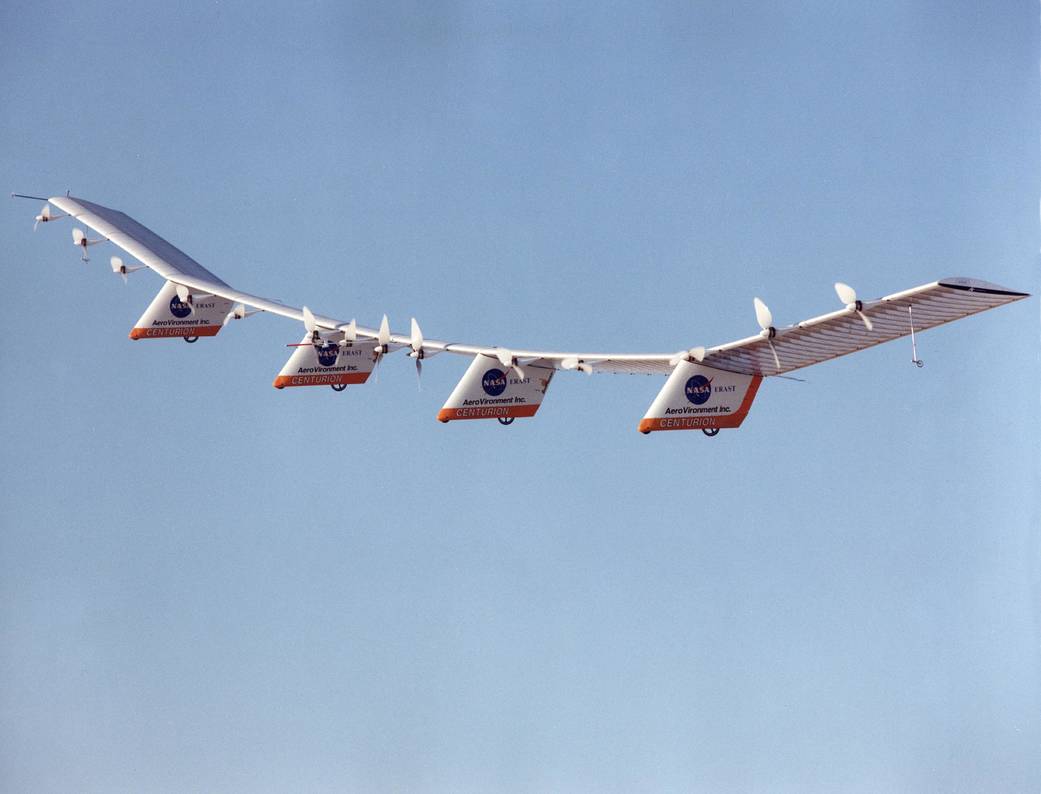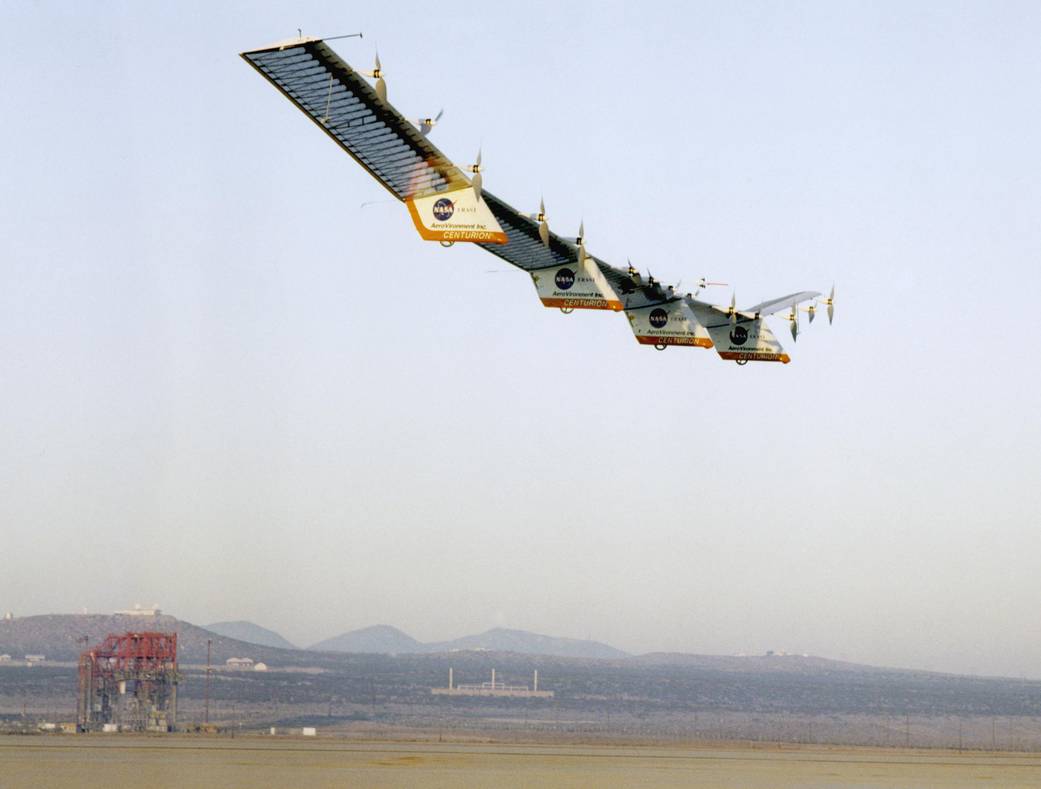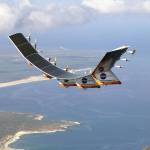Centurion Remotely Piloted Solar-Powered Airplane
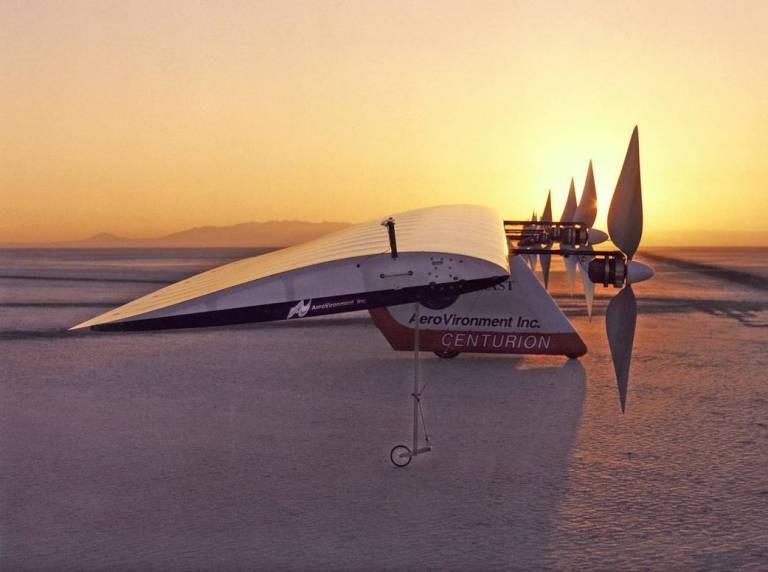
Envision an aircraft that can fly at the edge of the atmosphere for hours on end, slowly and silently soaring while its sensors and instruments record data for scientists on the Earth some 19 miles below. Envision it doing so on a renewable, virtually inexhaustible energy source that is non-polluting: the Sun.
Welcome to the world of Centurion, a unique remotely piloted solar-powered airplane developed under NASA’S ERAST (Environmental Research Aircraft and Sensor Technology) project at NASA’s Dryden (now Armstrong) Flight Research Center in Edwards, California.
Under the ERAST Joint Sponsored Research Agreement, NASA Dryden joined with AeroVironment Inc., headquartered in Monrovia, California, to design, develop, manufacture, and conduct developmental flight tests of the Centurion, the first aircraft believed capable of achieving sustained horizontal flight at altitudes of 90,000 to 100,000 feet. Being able to fly at these altitudes met an ERAST goal of developing an ultra-high altitude aircraft, to meet the needs of the science community to perform upper-atmosphere environmental data missions.
AeroVironment Inc. designed Centurion to not only reach extreme altitudes, but to do so while carrying 100 pounds of remote sensing and data collection instruments for use in scientific studies of the Earth’s environment. It also was capable of carrying 600 pounds of sensors, telecommunications and imaging equipment up to 80,000 feet altitude, and of performing multi-week flights at the north or south poles during summer.
Under its agreement with AeroVironment, NASA Dryden was responsible for monitoring and oversight of the Centurion development project. Dryden also was responsible for ensuring the safety of flying and ground operations, coordination of facilities, development of potential payloads that could be carried by the aircraft, and conducting independent reviews of aircraft systems and operations.
The ERAST Project
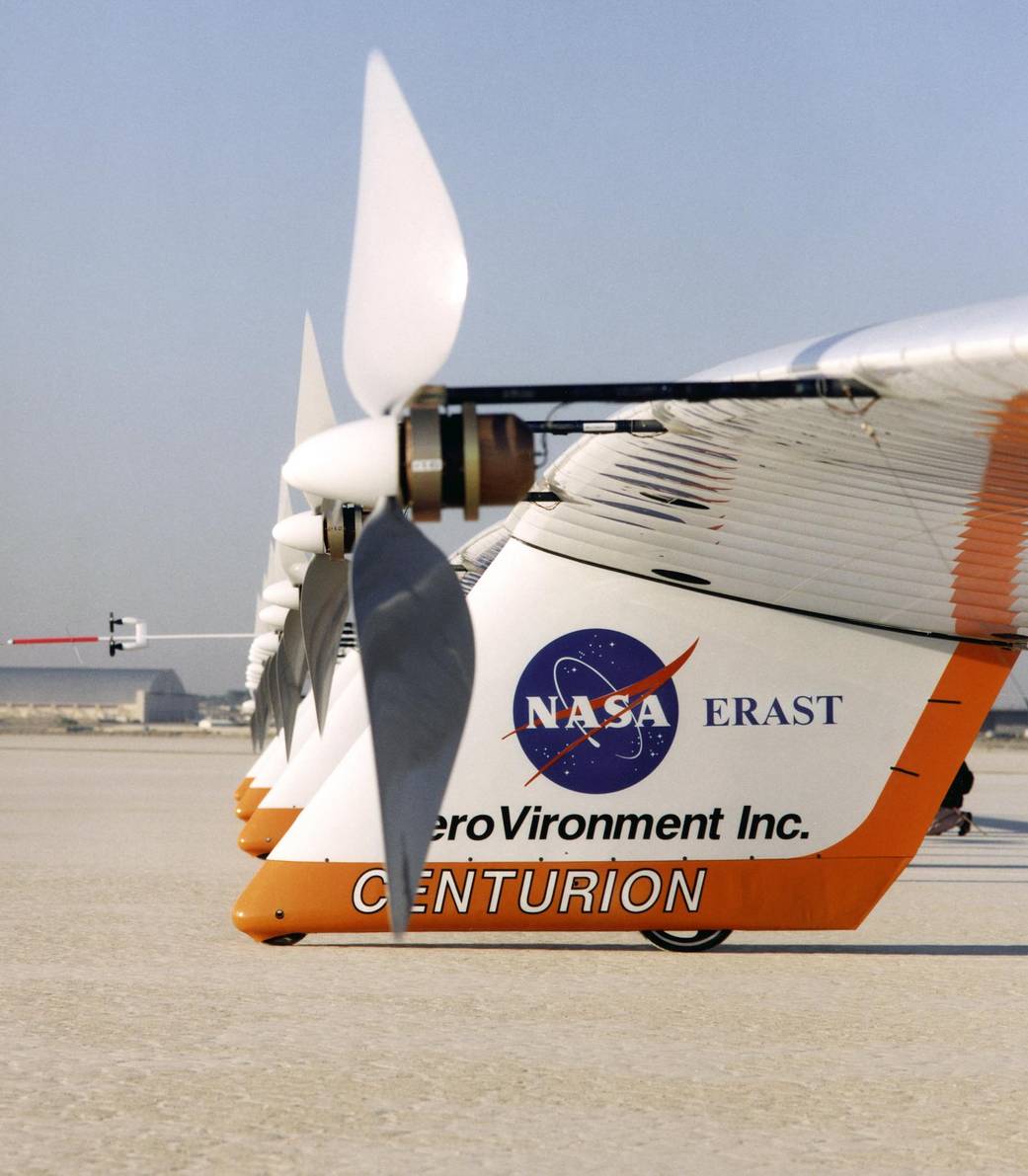
ERAST was a NASA initiative designed to develop the new technologies needed to continue America’s leadership in the highly competitive aerospace industry.
The primary focus of ERAST was on the development of slow-flying remotely-operated aircraft suited for long-duration science missions at very high altitudes (above 60,000 feet). These missions included remote sensing for Earth sciences studies, hyperspectral imaging for agriculture monitoring, tracking of severe storms, and serving as telecommunications relay platforms. The most extreme mission envisioned reached altitudes of 100,000 feet.
A parallel effort was developing lightweight, micro-miniaturized sensors that can be carried by these aircraft. Additional technologies considered by the joint NASA-industry ERAST Alliance included lightweight materials, avionics, aerodynamics, and other forms of propulsion suitable for extreme altitudes and duration.
Although ERAST Alliance member firms were responsible for aircraft development and operation, NASA had primary responsibility for overall mission and project success. As such, NASA provided overall project leadership, major funding, individual project management, development and coordination of payloads, and oversees operational safety. NASA also worked long-term issues with the Federal Aviation Administration and developing technology to make operation of these remotely operated aircraft in national airspace practical.
Aircraft Description
The Centurion was a state-of-the-art advance over the technology first developed in the Pathfinder flying wing and its follow-on, the Pathfinder-Plus, that set an unofficial world altitude record for solar-powered aircraft of 80,201 feet in the summer of 1998. The altitude was also the highest ever achieved by a propeller-driven aircraft.
Like its immediate predecessors, Centurion was a lightweight, solar-powered, remotely piloted flying wing aircraft that demonstrated the technology of applying solar power for long-duration, high-altitude flight. It was considered to be a prototype technology demonstrator for a future fleet of solar-powered aircraft that could stay airborne for weeks or months on scientific sampling and imaging missions.
Although it shared many of the design concepts of the Pathfinder, the Centurion had a wingspan of 206 feet, more than twice the 98-foot span of the original Pathfinder and 70% longer than the Pathfinder-Plus’ 121-foot span. At the same time, it maintained the eight-foot chord (front to rear distance) of the Pathfinder wing, giving the Centurion wing an aspect ratio (length-vs.-chord) of 26 to 1.
Other visible changes from its predecessor included a modified airfoil designed for flight at extreme altitude and four underwing pods to support its landing gear and electronic systems, compared with two such pods on the Pathfinder. The flexible wing was primarily fabricated from carbon fiber and graphite epoxy composites and Kevlar. It was built in five sections, a 44-foot-long center section and middle and outer sections just more than 40 feet long. All five sections had an identical thickness of 12% chord, or about 11.5 inches, with no taper or sweep. The outer panels had a pronounced 10-degree dihedral (upsweep) to assist in lateral stability, and a slight “washout,” or upward twist, at the tips of the trailing edge to prevent tip stall on landing or in turns.
Solar arrays that covered most of the upper wing surface provided up to 31 kilowatts of power at high noon on a summer day to power the aircraft’s 14 electric motors, avionics, communications, and other electronic systems. Centurion also had a backup lithium battery system that provided power for between two and five hours to allow limited-duration flight after dark. Initial low-altitude test flights at Dryden in 1998 were conducted on battery power alone, prior to installation of the solar cell arrays.
Centurion flew at an airspeed of only 17 to 21 mph, or about 15 to 18 knots. Although pitch control was maintained by the use of a full-span 60-segment elevator on the trailing edge of the wing, turns and yaw control were accomplished by applying differential power – slowing down or speeding up the motors – on the outboard sections of the wing.
The 'Eternal Airplane'
Although Centurion represented the state of the art in solar-powered flight at that time, it was just another rung on the ladder toward achieving semi-perpetual flight for extended-duration science studies, an ultimate goal of the ERAST project and of AeroVironment’s solar aircraft developments. The next steps were “Centelios” and “Helios,” the follow-on vehicles to Centurion.
The Centelios, a transitional aircraft like the Pathfinder-Plus, was a hybrid between the Centurion and the Helios. The Centelios was an upgrade of the Centurion, but with a rechargeable fuel-cell energy storage system installed to provide electrical power for night flying. A sixth wing section, increasing wingspan to about 250 feet, was required to carry the additional weight of the fuel cell system. The Centelios was designed to remain aloft above 60,000 feet altitude for at least four days and nights, meeting an ERAST Level I milestone set for 2005.
The Helios was intended to be the ultimate “eternal airplane,” designed to fly for up to four months at a time at altitudes from 50,000 to 70,000 feet while carrying a 200-pound payload. It could operate year-round in the tropics, and up to the north and south poles during local summers. Similar to the Centurion in design, the Helios had a slightly longer wingspan of about 220 feet and refinements to increase long-term systems reliability.
For Helios to achieve its mission, however, advanced fuel cell technology with increased efficiency and lower weight were required. Since the weight of battery systems makes them impractical, the focus was on improving the efficiency of lightweight hydrogen-oxygen fuel cells and electrolyzers, whose weight was about half of battery systems of comparable capacity. Once such fuel cell systems were developed, the ultimate solar flying machine, capable of flying day and night for months on end, could become reality.
Project Management
The ERAST project is sponsored by the Office of Aeronautics and Space Transportation Technology at NASA Headquarters, and was managed by NASA Dryden. Sensor technology development was headed by NASA’s Ames Research Center in Moffett Field, California. The Centurion was designed and manufactured by AeroVironment, Inc. in Monrovia, California, at the firm’s Design and Development Center in Simi Valley, California.
Aircraft Specifications
- Wingspan: 206 feet (61.8 meters).
- Length: 12 feet (3.6 meters).
- Wing chord: 8 feet (2.4 meters).
- Wing thickness: 12% of chord.
- Wing area: 1,648 square feet.
- Wing loading: 0.66 pounds per square feet.
- Aspect ratio: 26 to 1.
- Empty weight: About 1,175 pounds (529 kg).
- Gross weight: Varies depending on power availability and mission profile; approximately 1,900 pounds for a mission to 80,000 feet altitude.
- Payload: Varies depending on altitude; about 100 pounds to 100,000 feet, 600 pounds to 80,000 feet.
- Power: Bi-facial solar cells, covering 80% of the upper wing surface, maximum output about 31 kw (Initial test flights battery-powered.).
- Motors: 14 brushless direct-current electric motors, 1.5 kw (2 hp) each.
- Propellers: two-blade, wide-chord, laminar-flow designed for high altitudes, 79 inches diameter.
- Airspeed: Approx. 17-21 mph (27 to 33 km, 15-18 knots) cruise.
- Altitude: Up to 100,000 feet (30 km, 19 miles).
- Endurance: About 14 to 15 hours, daylight limited with two to five hours on backup lithium batteries.
- Primary materials: Carbon fiber and graphite epoxy composite structure, KevlarTM, styrofoam leading edge, plastic film covering.



























